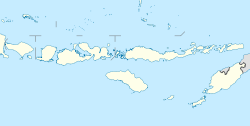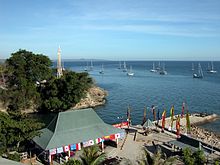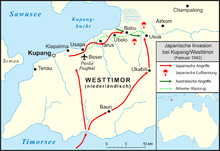Kupang
| Kupang City Kota Kupang Kupang |
||
|---|---|---|
|
|
||
| Coordinates | 10 ° 11 ′ S , 123 ° 36 ′ E | |

|
||
| Symbols | ||
|
||
| Basic data | ||
| Country | Indonesia | |
|
Geographical unit |
Nusa Tenggara | |
| province | Nusa Tenggara Timur | |
| ISO 3166-2 | ID-NT | |
| surface | 160.3 km² | |
| Residents | 434,972 (2019) | |
| density | 2,712.8 Ew. / km² | |
| Website | www.kupangkota.go.id (Indonesian) | |
|
Panorama (2016)
|
||
Kupang (in the old port. Sources Cuppão or Cupão , cu. Koepang ) is the capital of the Indonesian province of East Nusa Tenggara . The city is a separate administrative unit with 160.34 km² within the province. Kupang is the largest city and port on the island of Timor.
geography
The city is located in the southwest of the island of Timor , on the southern bank of the Bay of Kupang on the Sawu Sea and has 434,972 inhabitants (2019). On the land side, the city is enclosed by the Kupang government district . As a bishopric and university town (since 1962) it has a special meaning in the region. Kupang lives economically from trade ( export port ) and the cement industry . About 8 km east of the city center near Penfui is Kupang 's El Tari Airport , which also serves as an air force base.
Kupang City ( Kota Kupang ) is divided into six districts ( Kecamatan ), which in turn are divided into villages ( Kelurahan ):
- Alak (12 Kelurahan)
- Kelapa Lima (5 Kelurahan)
- Kota Raja (8 Kelurahan)
- Kota Lama (10 Kelurahan)
- Maulafa (9 Kelurahan)
- Oebobo (7 Kelurahan)
history

Kupang Bay was considered the best natural harbor on the entire island. Traders came here early to buy sandalwood , and from the 16th century Portuguese traders also came here . A small Portuguese fort was built here early on, but it was conquered by the Dutchman Apollonius Schotte . He left 50 soldiers behind, but the Dutch gave up the base as early as 1616. In 1640 a Dutch post was set up on the bay. In 1642 the ruler of Kupang converted to Christianity and concluded an alliance with the Portuguese. They built a simple fort again. In 1644 two Dutch attacks failed, the second with 300 soldiers, who were additionally supported by a large number of mercenaries. The Dominicans then built a new fortress under António de São Jacinto in 1647. In 1649, Captain-Major Francisco Carneiro became the new commandant of the fortress. In 1653 the Dutch destroyed the Portuguese post, but could be repulsed again. On January 27, 1656, the Dutch finally conquered Kupang with a strong force made up of Europeans and Indians under General Arnold de Vlamigh van Outshoorn . Vlamingh pursued the Portuguese and their Topasse allies under António da Hornay to the village of Amarasi , where there was a heavy battle in which Vlamingh lost 170 European soldiers. He was forced to withdraw from Kupang again. The Dutch sphere of influence was temporarily limited to the small region around the Bay of Kupang. By 1688 the Dutch East India Company (VOC) concluded treaties with the five small rulers in this area, the "five loyal allies" Sonbai Kecil , Amabi , Kupang- Helong , Amfo'an and Taebenu . In this year the Portuguese fortress in Kupang was finally captured. The fort was renamed Concordia . The alliance between the VOC and the Timorese allies was very stable. During this time there were only two rebellions, which were triggered by Timorese forces: In 1678, Raja Ama Besi of Kupang allied with the pro-Portuguese Amarasi to attack the successor to his throne. In 1744 a subordinate nobleman rebelled against the Raja of Kupang.
In 1697, French pirates robbed the fortress. They later attacked Lifau further north. 1749 failed an attempt to recapture Kupang by the Portuguese and Topasse , the mixed Portuguese-Malay population. Many Topasse leaders were killed at the Battle of Penfui . As a result of this defeat, most of the native empires of West Timor turned away from the Portuguese and submitted to the Dutch.
William Bligh reached the place with his followers on June 14, 1789, after being abandoned at sea during the mutiny on the Bounty .
In 1797 the British tried to occupy Kupang because it was feared that France might establish itself here. The British were driven out by the Dutch commandant with the help of locals and slaves. During the Napoleonic Wars , the British succeeded in occupying Kupang in 1811. In 1812 British control was extended to all of Dutch West Timor. Only after the return of the Orange to the Dutch throne did the Dutch officially get their Timorese possessions back on October 7, 1816.
The rulers of Kupang saw themselves as descendants of crocodiles . Therefore, a sacrifice was publicly made to enthrone new rulers in saltwater crocodiles . This consisted of a pig with red bristles and a young girl. The girl was festively dressed, perfumed and decorated with flowers. They were then brought to the bank and tied to a sacred stone in a cave. Then one of the ruler's guardians called the crocodiles, who then killed the girl. The residents of Kupang saw the girl as the bride of the crocodiles. If she wasn't a virgin, it was believed that the crocodiles would bring her back. At other festivities, a newborn girl was consecrated to crocodiles and later married to a priest.
In 1917 the five loyal allies were united to form the new zelfbesturend landschap (self-governing area) Kupang. The new Raja of Kupang came from the Nisnoni family , a sideline of the Sonba'i . In February 1942, Kupang was one of the first targets of the Japanese invasion of Timor . In 1949 the Kupang area had 49,168 inhabitants. In 1955, the Indonesian central government ended the local monarchy in Kupang.
Facilities
The Catholic University of Widya Mandira and the Universitas Nusa Cendana are located in Kupang .
East Timor has a consulate general in Kupang.
See also
Web links
- The King of Kupang ( Memento from January 29, 2009 in the Internet Archive )
Individual evidence
- ↑ Penduduk Kota Kupang tahun 2019 - BPS Kota Kupang
- ↑ http://ntt.bps.go.id/ ( Memento from July 21, 2011 in the Internet Archive )
- ↑ Hans Hägerdal: Rebellions or factionalism? Timorese forms of resistance in an early colonial context, 1650–1769 ( Memento of the original from December 8, 2015 in the Internet Archive ) Info: The archive link was inserted automatically and has not yet been checked. Please check the original and archive link according to the instructions and then remove this notice.
- ↑ a b History of Timor ( Memento of the original from March 24, 2009 in the Internet Archive ) Info: The archive link was inserted automatically and has not yet been checked. Please check the original and archive link according to the instructions and then remove this notice. (PDF; 824 kB) - Technical University of Lisbon
- ↑ Monika Schlicher: Portugal in East Timor. A critical examination of the Portuguese colonial history in East Timor from 1850 to 1912 . Abera, Hamburg 1996, ISBN 3-931567-08-7 , ( Abera Network Asia-Pacific 4), (also: Heidelberg, Univ., Diss., 1994).
- ↑ James George Frazer: The Golden Bough , Cambridge 2012, ISBN 1-108-04731-9 .
- ↑ Matthew Libbis BA (Hons) Anthropology: Rituals, Sacrifice & Symbolism in Timor-Leste , accessed February 18, 2015.
- ^ Royal Timor: Sonbai ( Memento from July 15, 2011 in the Internet Archive )
- ↑ a b H. G. Schulte Nordholt: The political system of the Atoni of Timor, Den Haag (1971) p. 155.
- ↑ Website of the Treasury: Profiles: Vice-Minister of Finance, Ms. Santina JRF Viegas Cardoso , accessed on February 24, 2015.
- ^ [Website of the Universitas Nusa Cendana], accessed on October 12, 2015.
- ^ Government of East Timor: Embaixadas de Timor-Leste , accessed on July 6, 2016.







